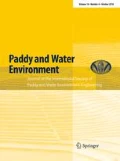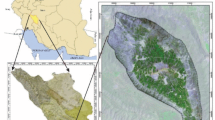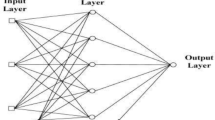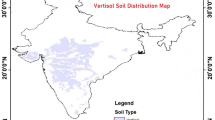Abstract
The saturated hydraulic conductivity (\(K_{\text{s}}\)) is one of the important soil hydraulic properties which plays a significant role in developing flow transport models and irrigation and drainage practices. In this research, artificial neural networks approaches, group method of data handling (GMDH) model and a hybrid intelligent model based on combination of GMDH and harmony search (HS) model (GMDH-HS) were developed to estimate \(K_{\text{s}}\) based on 151 field samples collected from the northeast of Iran. Eleven topsoil properties were used as input parameters to estimate \(K_{\text{s}}\). The five quantitative standard statistical performance evaluation measures, i.e., coefficient of efficiency, root-mean-square error, mean square relative error, mean absolute percentage error and relative bias, were employed to evaluate the performance of various developed models. Statistical results indicated that the best performance can be obtained by GMDH-HS in terms of different evaluated criteria during the training and testing datasets for \(K_{\text{s}}\) estimation.









Similar content being viewed by others
References
Agyare WA, Park SJ, Vlek PLG (2007) Artificial neural network estimation of saturated hydraulic conductivity. VZJ 6:423–431
Arrey IA, Odiyo JO, Makungo R, Kataka MO (2017) Effect of hysteresis on water flow in the vadose zone under natural boundary conditions, Siloam Village case study, South Africa. J Hydroinform 20(1):88–99
Ayvaz MT (2009) Application of harmony search algorithm to the solution of groundwater management models. Adv Water Resour 32:916–924
Babaeian E, Homaee M, Montzka C, Vereecken H, Norouzi AA (2015) Towards retrieving soil hydraulic properties by hyperspectral remote sensing. VZJ 14:1–17
Chen SF (2005) Complex systems modeling theory and methods. Southeast university Press, Nass Jing
Das SK, Samui P, Sabat AK (2011) Prediction of field hydraulic conductivity of clay liners using an artificial neural network and support vector machine. Int J Geomech 12:606–611
Deng J, Chen X, Du Z, Zhang Y (2011) Soil water simulation and predication using stochastic models based on LS-SVM for red soil region of China. EWRA 25:2823–2836
Geem ZW, Kim JH, Loganathan GV (2001) A new heuristic optimization algorithm: harmony search. SAGE 76:60–68
Hsu KL (2011) Hydrologic forecasting using artificial neural networks: a Bayesian sequential Monte Carlo approach. J Hydroinform 13:25–35
Ivakhnenko AG (1968) The group method of data handling-a rival of the method of stochastic approximation. Sov Automatic Control 1(3):43–55
Ivakhnenko AG, Ivakhnenko GA (2000) Problems of further development of the group method of data handling algorithms. Part I. Pattern Recognit Image Anal C/C of raspoznavaniye obrazov I analiz izobrazhen II. 10:187–194
Kargas G, Kerkides P, Sotirakoglou K, Poulovassilis A (2016) Temporal variability of surface soil hydraulic properties under various tillage systems. Soil Tillage Res 158:22–31
Le Bourgeois O, Bouvier C, Brunet P, Ayral PA (2016) Inverse modeling of soil water content to estimate the hydraulic properties of a shallow soil and the associated weathered bedrock. J Hydrol 541:116–126
Lee KS, Geem ZW (2005) A new meta-heuristic algorithm for continuous engineering optimization: harmony search theory and practice. Comput Methods Appl Mech Eng 194:3902–3933
Masoumi Shahr-Babak M, Khanjani MJ, Qaderi K (2016) Uplift capacity prediction of suction caisson in clay using a hybrid intelligence method (GMDH-HS). Appl Ocean Res 59:408–416
McKenzie N, Jacquier D (1997) Improving the field estimation of saturated hydraulic conductivity in soil survey. Soil Res 35:803–827
Minasny B, Hopmans JW, Harter T, Eching SO, Tuli A, Denton MA (2004) Neural networks prediction of soil hydraulic functions for alluvial soils using multistep outflow data. Soil Sci Soc Am J 68:417–429
Muller JA, Ivakhnenko AG (1996) Self-organizing modelling in analysis and prediction of stock market. In: Proceedings of the second international conference on application of fuzzy systems and soft computing—ICAFS, vol 96, pp 491–500
Nemes A, Rawls WJ, Pachepsky YA (2005) Influence of organic matter on the estimation of saturated hydraulic conductivity. Soil Sci Soc Am J 69:1330–1337
Rawls WJ, Brakensiek DL (1985) Prediction of soil water properties for hydrologic modelling. In: Jones EB, Ward TJ (eds) Proceedings of a symposium watershed management in the eighties. New York, 30 April–1 May 1985, pp 293–299
Santos FL, Jesus VAMD, Valente DSM (2012) Modeling of soil penetration resistance using statistical analyses and artificial neural networks. Acta Sci Agron J 34:219–224
Shamseldin AY, O’connor KM, Nasr AE (2007) A comparative study of three neural network forecast combination methods for simulated river flows of different rainfall—runoff models. HSJ 52:896–916
Solomatine DP, Ostfeld A (2008) Data-driven modelling: some past experiences and new approaches. J Hydroinform 10:3–22
Ungaro F, Calzolari C, Busoni E (2005) Development of pedotransfer functions using a group method of data handling for the soil of the Pianura Padano-Veneta region of North Italy: water retention properties. Geoderma 124:293–317
Wang WC, Chau KW, Cheng CT, Qiu L (2009) A comparison of performance of several artificial intelligence methods for forecasting monthly discharge time series. J Hydroinform 374:294–306
Wu CL, Chau KW (2006) A flood forecasting neural network model with genetic algorithm. IJEP 28:261–273
Xiang WL, An MQ, Li YZ, He RC, Zhang JF (2014) An improved global-best harmony search algorithm for faster optimization. Expert Syst Appl 41:5788–5803
Yoon H, Hyun Y, Lee KK (2007) Forecasting solute breakthrough curves through the unsaturated zone using artificial neural networks. J Hydrol 335:68–77
Author information
Authors and Affiliations
Corresponding author
Rights and permissions
About this article
Cite this article
Qaderi, K., Jalali, V., Etminan, S. et al. Estimating soil hydraulic conductivity using different data-driven models of ANN, GMDH and GMDH-HS. Paddy Water Environ 16, 823–833 (2018). https://doi.org/10.1007/s10333-018-0672-9
Received:
Revised:
Accepted:
Published:
Issue Date:
DOI: https://doi.org/10.1007/s10333-018-0672-9




